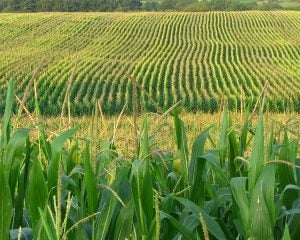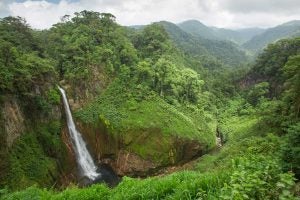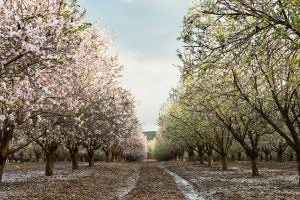‘Tis the season – for planting that is.
Unquestionably my favorite time of the year. After a winter slumber — a much needed break from the intensely draining seasonality of vegetables — we’re (re)blossoming in sync with nature. No worries about harvest or getting produce to market. Just the operational simplicity of getting the crop in the ground.
It’s a humble, if one-sided goal. But what’s often in the crosshairs of activists is the philosophy of the planting system — the “dreaded” monoculture.
Row crops are a relic, say self-styled pundits in the sustainability debate.

Indian activist Vandana Shiva touts her surreally titled book “Monocultures of the Mind,” defying the prevailing mindset and conformity of row crops.
In the closing segment of the BBC’s acclaimed Reith Lecture Series, Prince Charles agreed, proposing that we work “with the grain of nature” and follow the “genius of nature’s clearly defined boundaries.”
After straying too far from nature’s bosom, they say it’s time to square up with polyculture, a mosaic inspired by the rainforest. What does this mean? Grow multiple crops in a shared space. Shun that one-dimensional simplification for a more intricate ecosystem. The selling points are perennial stability, productivity, and built-in checks and balances that keep pests and diseases at bay.
Certainly sounds appealing. In their view, it’s naive to think something so elegantly simple can sustainably provide. If monoculture is a 100 level basket-weaving class for unambitious and shortsighted, polyculture is an all-out doctoral dissertation for the studious and eco-aligned.
Seems like a Rube Goldberg complex though — insufferable complexity just for the sake of it. Ironically, nature’s model is best suited to provide food and fiber — only salvation isn’t the miracle system the Prince is peddling.
Though no farm can ever hope (nor should they want to) faithfully replicate a wild ecosystem, current methods seem to be well grounded. In fact, researcher David Wood thinks Mother Nature would be flattered at the lengths we’ll go to mimic her.
Questioning the theory that cereals (not the milk in a bowl kind, at least not directly!) first arose as weeds on the outskirts of human settlements, Wood found that they exist today as vast monocultures along ancient waterways. Frequent floods would flush these stands with nutrient rich sediment; much in the same way a farmer spreads fertilizer in the field.
For centuries, wild rice was widely harvested as a staple crop from southern Sudan to the Atlantic. Wood suggests that early farmers had a working knowledge of this system and adapted it, realizing the precedents set in nature’s fields.
Even though wet rice has been sustained on the same land for millennia, Miguel Altieri of UC-Berkeley claims that monocultures are inherently unstable because they “provide optimal conditions for the unhampered growth of weeds, insects, and diseases because ecological niches are not filled by other organisms.”

The alternative is to model our ambitions on the rainforest. Hosting perhaps 25 million of the Earth’s 30 million wild species, it remains a hotspot of biodiversity. With limited resources, organisms effectively keep the peace by filling the least intrusive niches and avoiding competition at all costs. Skirmishes for resources are just too costly. Though productivity (in terms of sheer plant biomass) remains high, few of those gains are edible or of economic value to a farmer.
Indeed, the rainforest’s treasure trove of life is largely a last ditch effort to survive.
Suggesting such a model for food production is counterintuitive. Blistering heat robs the soil of nutrients and tilth, and yields suffer. In the Amazon, growers are resigned to slash and burn, while U.S. farmers still tend the land that their forefathers cleared centuries before.
They didn’t know it, but early pioneers extended the historical reign of monodominance by selecting the best land, leaving the marginal areas (which host a much broader spectrum of life) as a last resort. This is the polyculture (and often by association, organic) paradox.
It’s also a textbook case in ecology. When resources are plentiful, a few species dominate. Opportunists need not be pests, as Altieri claims. Nobel Laureate Norman Borlaug capitalized on this principle to develop high-yielding wheat strains responsive to fertilizer and other inputs. In the process he saved a billion lives and 12 million square miles of wildlife habitat.

The Green Revolution taught us that the key to averting human misery and wildlife loss is properly pairing land with practice. We can be intentional by conscripting the “best” land (which tends to trend monodominant anyway), and spare the rich biodiversity in poor(er) real estate. This land sparing ensures maximum productivity on the smallest footprint, sustaining us and leaving more land for nature.
Far from failing the eco-palatability taste test, the take home message is to embrace a monoculture in both mind and practice — using nature’s forgotten fields as inspiration. Farmers can (and should) still leverage crop rotation and fallowing to keep pests and pathogens from building to intolerable levels. No one is suggesting they grow the same crop year in, year out, in the same space. That’s the definition of insanity — not monoculture.
Turns out the deceptively simple monoculture playbook has been right all along. As an eco-foray in conservation, food security, and social justice, polyculture is a recurring fad that’s doomed to fail.
Tim Durham’s family operates Deer Run Farm — a truck (vegetable) farm on Long Island, New York. As a columnist and agvocate, he counters heated rhetoric with sensible facts. Tim has a degree in plant medicine and is an Associate Professor at Ferrum College in Virginia.



